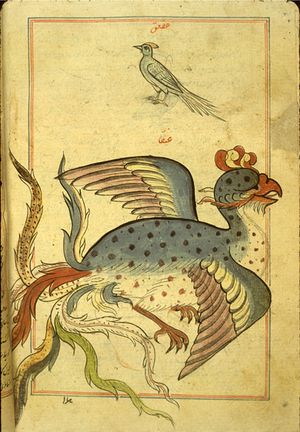「アンカ」の版間の差分
(→関連項目) |
|||
| (同じ利用者による、間の32版が非表示) | |||
| 7行目: | 7行目: | ||
しかし''ʿAnqāʾ''、ʿはʾanāq(عناق「不幸、つらい出来事」)とも関係があり、muḡribとともに災難の意味で使われていた<ref name="lane"/>。それは、この鳥はもともとすべて完璧に創られたが、疫病や災いとなり、殺されてしまったと言われているからである<ref>Phoenix (mythological bird) , https://www.britannica.com/topic/phoenix-mythological-bird#ref263489 , Encyclopedia Britannica , access-date:3 October 2019 </ref><ref>Abi Fadel , Marwan , Honouring the gods in the classical Mediterranean realm and on its fringes - The phoenix in Arab-Muslim sources , http://hemed.univ-lemans.fr/cours2012/en/co/grain5.html , hemed.univ-lemans.fr</ref>。 | しかし''ʿAnqāʾ''、ʿはʾanāq(عناق「不幸、つらい出来事」)とも関係があり、muḡribとともに災難の意味で使われていた<ref name="lane"/>。それは、この鳥はもともとすべて完璧に創られたが、疫病や災いとなり、殺されてしまったと言われているからである<ref>Phoenix (mythological bird) , https://www.britannica.com/topic/phoenix-mythological-bird#ref263489 , Encyclopedia Britannica , access-date:3 October 2019 </ref><ref>Abi Fadel , Marwan , Honouring the gods in the classical Mediterranean realm and on its fringes - The phoenix in Arab-Muslim sources , http://hemed.univ-lemans.fr/cours2012/en/co/grain5.html , hemed.univ-lemans.fr</ref>。 | ||
| − | == | + | == 特徴 == |
| − | + | アンカは「非常に美しく、色鮮やかで、長い首、人間の顔、4対の翼<ref>"و في زمن موسى عليه السلام طائرة اسمها العنقاء لها أربعة أجنحة من كل جانب (.. モーセの時代、アル・アンカという名の鳥は、左右に四つの翼を持ち-->)</ref> 、あらゆる生物と何らかの類似性がある<ref>"و كانت العنقاء طائرة عظيمة الخلق، لها وجه إنسان، و فيها من كل حيوان شبه (..その中には多くの鳥がおり、その中の一羽であるアンカは、体が大きく、首が長く、人間の顔をしている。--></ref>」とされ、首には「白さ」があるとされた<ref>Al-Farahidi-quote , والعَنْقاءُ: طائِرٌ لم يَبْقَ في أيدي الناس من صِفتها غيرُ اسمِها. ويقالُ بل سُمِّيَتْ به لبياضٍ في عُنقِها كالطَّوق. "アンカ:もはや名前だけしか知られていない鳥。 首の周りに襟のような白さがあることから、その名がついたと言われている。"</ref><ref>=Lane Edward William , Arabic-English Lexicon , date:1863 , Cosimo Classics , London , isbn:9781616408985 , page:2244 , http://www.tyndalearchive.com/TABS/Lane// , access-date:3 October 2019</ref>。ザカリヤ・アル・カズウィーニーは、この宇宙論的著書『被造物の驚異と万物の珍奇』の中で、アンカについて「カフ山に単独で住んでいた鳥の親族」「多くの時代を通じて得た経験を持つ賢鳥で、戒めや道徳的助言を与える」とコメントしている<ref name="wonders">Qazwīnī , Zakarīyā Ibn-Muḥammad al- , Kosmographie: ¬Die Wunder der Schöpfung , 1849 , Dieterich |url=https://books.google.com/books?id=eCk-AAAAcAAJ&pg=PT152 , access-date:3 October 2019</ref>。また、カズウィーニーによると、この鳥は1700年生き、500歳で交尾し、卵が割れた後のヒナは中にとどまり、125年後に初めて出てくるのだという<ref name="wonders"/>。 | |
| − | + | アンカは、象と大きな魚以外は食べないと言われている<ref>فذهب الله به إلى جزيرة بعض جزائر البحر المحيط تحت خط الاستواء و هي جزيرة لا يصل إليها الناس، و فيها حيوانات كثيرة كالفيل و الكركند و الجاموس و النمر و السباع و جوارح الطير و العنقاء لا تصي منها لأنهم تحت طاعتها، و إذا أتى بشيء من الصيد يأكل منه و الباقي تأكل منه الحيوانات التي تحت طاعتها، و لا تصيد إلا فيلًا أو سمكًا عظيمًا أو تنينًا (.. | |
| − | + | そして、神はアンカを赤道直下の周辺海域の島の一つに連れて行った。そこは人の手の届かない島で、象、ロブスター、水牛、ヒョウ、肉食動物、猛禽類など多くの動物がいる一方、アンカはそれらの動物を一切狩らず、すべてをアンカの支配下におくためにだった。ただし、アンカが何かを狩った場合、アンカはそれを食べ、残りの獲物はアンカの支配下にある動物に食べられてしまう。アンカが狩るのは、ゾウ、大魚、タンニンだけである。--></ref>。 | |
| − | === | + | === 特徴 === |
| − | + | アンカはアルメニアやビザンティンの鷲、テュルクのコンルル(セムリュック<ref>Cirlot , J. E. , A Dictionary of Symbols , date:2013 , Courier Corporation , isbn:9780486132662 , https://books.google.com/books?id=_p7DAgAAQBAJ</ref>とも呼ばれる)と共にペルシア神話の[[シームルグ]]としばしば(同義になるほど)同一視されるが、これはおそらくペルシア帝国の影響圏の広さのせいである<ref>SIMORḠ – Encyclopaedia Iranica , http://www.iranicaonline.org/articles/simorg , www.iranicaonline.org , access-date:3 October 2019</ref>。また、ほとんどの場合、[[フェニックス]]のように艶やかに描かれる。トルコ語では、不死鳥であるコンルールの別名は、''zümrüdü anka''「エメラルドのアンカ」である。現代アラビア語では、Anqaは[[フェニックス]]または[[グリフォン]]と認識されている。 | |
== 関連項目 == | == 関連項目 == | ||
* [[シームルグ]] | * [[シームルグ]] | ||
* [[フェニックス]] | * [[フェニックス]] | ||
| − | * | + | * カルキドリ, 「第二エノク書」に登場する[[フェニックス]]に似た合成鳥 |
| − | * [[ロック鳥]], | + | * [[ロック鳥]], アラブの民話で有名な中東の伝説上の巨大な鳥 |
| − | * | + | * アンズー, メソポタミア神話の巨大な鳥神あるいは怪物 |
| − | * | + | * コンルル, ツムルードのアンカとして知られている |
* カフ山 | * カフ山 | ||
== 参考文献 == | == 参考文献 == | ||
| − | * Wikipedia:[https://en.wikipedia.org/wiki/Anqa Anqa] | + | * Wikipedia:[https://en.wikipedia.org/wiki/Anqa Anqa](最終閲覧日:22-05-20) |
| − | == | + | == 詳細な資料 == |
| − | * ''Wafayat al-aʼyan'' by | + | * ''Wafayat al-aʼyan'' by Ibn Khallikan biography number 349 |
| − | * ''Lisān al-ʿArab'' by | + | * ''Lisān al-ʿArab'' by Ibn Manzur part 10 page 276 |
| − | * ''The Wonder of Creation'' by | + | * 『被造物の驚異と万物の珍奇』(''The Wonder of Creation'') by Zakariya al-Qazwini |
| − | * ''' | + | * '''Kitab al-'Ayn''' by ibn Ahmad al-Farahidi |
| − | |||
| − | |||
| − | |||
== 参照 == | == 参照 == | ||
| − | |||
{{DEFAULTSORT:あんか}} | {{DEFAULTSORT:あんか}} | ||
2022年5月20日 (金) 06:55時点における最新版
アンカ(アラビア語:عَنْقَاء、ローマ字表記:ʾAnqāʾ)[1]、またはAnka、またはアンカ・ムーグリブ(Anqa Mughrib)、アンカ・アル・ムーグリブ(アラビア語:العَنْقَاء المُغْرِب、ローマ字表記:Anqa al-Mughrib)とも表記される。)[2]は、アラビア神話に登場する大きくて神秘的な、あるいは素晴らしい雌の鳥である。アンカは遠くまで飛び、何年かに一度しか現れないと言われている。しかし、アンカ「太陽が沈む場所」にも出没すると言われている[1]。
語源と注釈[編集]
アンカ(anqā)という言葉は、「首の長い」という意味の ʾaqnaq の女性形であり、「首が長くて太い」という意味でもある。これはおそらく、サギやツル(あるいは他の首の長い鳥)に似ている、あるいは単にワシやハヤブサ(あるいは他の猛禽類)のように大きな強い首を持っているという意味であり、アンカは一部でそれらの鳥と同一視されていたのだろう[1]。muḡribという言葉には、「奇妙な、外国の」「遠い、離れた」「西、日没」「荒涼とした、未知の」「白い、夜明け」などの意味があり、生物にまつわる謎や非現実を表現している。
しかしʿAnqāʾ、ʿはʾanāq(عناق「不幸、つらい出来事」)とも関係があり、muḡribとともに災難の意味で使われていた[1]。それは、この鳥はもともとすべて完璧に創られたが、疫病や災いとなり、殺されてしまったと言われているからである[3][4]。
特徴[編集]
アンカは「非常に美しく、色鮮やかで、長い首、人間の顔、4対の翼[5] 、あらゆる生物と何らかの類似性がある[6]」とされ、首には「白さ」があるとされた[7][8]。ザカリヤ・アル・カズウィーニーは、この宇宙論的著書『被造物の驚異と万物の珍奇』の中で、アンカについて「カフ山に単独で住んでいた鳥の親族」「多くの時代を通じて得た経験を持つ賢鳥で、戒めや道徳的助言を与える」とコメントしている[9]。また、カズウィーニーによると、この鳥は1700年生き、500歳で交尾し、卵が割れた後のヒナは中にとどまり、125年後に初めて出てくるのだという[9]。
アンカは、象と大きな魚以外は食べないと言われている[10]。
特徴[編集]
アンカはアルメニアやビザンティンの鷲、テュルクのコンルル(セムリュック[11]とも呼ばれる)と共にペルシア神話のシームルグとしばしば(同義になるほど)同一視されるが、これはおそらくペルシア帝国の影響圏の広さのせいである[12]。また、ほとんどの場合、フェニックスのように艶やかに描かれる。トルコ語では、不死鳥であるコンルールの別名は、zümrüdü anka「エメラルドのアンカ」である。現代アラビア語では、Anqaはフェニックスまたはグリフォンと認識されている。
関連項目[編集]
- シームルグ
- フェニックス
- カルキドリ, 「第二エノク書」に登場するフェニックスに似た合成鳥
- ロック鳥, アラブの民話で有名な中東の伝説上の巨大な鳥
- アンズー, メソポタミア神話の巨大な鳥神あるいは怪物
- コンルル, ツムルードのアンカとして知られている
- カフ山
参考文献[編集]
- Wikipedia:Anqa(最終閲覧日:22-05-20)
詳細な資料[編集]
- Wafayat al-aʼyan by Ibn Khallikan biography number 349
- Lisān al-ʿArab by Ibn Manzur part 10 page 276
- 『被造物の驚異と万物の珍奇』(The Wonder of Creation) by Zakariya al-Qazwini
- Kitab al-'Ayn by ibn Ahmad al-Farahidi
参照[編集]
- ↑ 1.0 1.1 1.2 1.3 Lane Edward William , Arabic-English Lexicon , 1863 , Cosimo Classics , London ,isbn:9781616408985 , page2177 , http://www.tyndalearchive.com/TABS/Lane// , access-date:3 October 2019
- ↑ مُغْرِب , Mughrib) is the person who throw people down toward west or during sunset
- ↑ Phoenix (mythological bird) , https://www.britannica.com/topic/phoenix-mythological-bird#ref263489 , Encyclopedia Britannica , access-date:3 October 2019
- ↑ Abi Fadel , Marwan , Honouring the gods in the classical Mediterranean realm and on its fringes - The phoenix in Arab-Muslim sources , http://hemed.univ-lemans.fr/cours2012/en/co/grain5.html , hemed.univ-lemans.fr
- ↑ "و في زمن موسى عليه السلام طائرة اسمها العنقاء لها أربعة أجنحة من كل جانب (.. モーセの時代、アル・アンカという名の鳥は、左右に四つの翼を持ち-->)
- ↑ "و كانت العنقاء طائرة عظيمة الخلق، لها وجه إنسان، و فيها من كل حيوان شبه (..その中には多くの鳥がおり、その中の一羽であるアンカは、体が大きく、首が長く、人間の顔をしている。-->
- ↑ Al-Farahidi-quote , والعَنْقاءُ: طائِرٌ لم يَبْقَ في أيدي الناس من صِفتها غيرُ اسمِها. ويقالُ بل سُمِّيَتْ به لبياضٍ في عُنقِها كالطَّوق. "アンカ:もはや名前だけしか知られていない鳥。 首の周りに襟のような白さがあることから、その名がついたと言われている。"
- ↑ =Lane Edward William , Arabic-English Lexicon , date:1863 , Cosimo Classics , London , isbn:9781616408985 , page:2244 , http://www.tyndalearchive.com/TABS/Lane// , access-date:3 October 2019
- ↑ 9.0 9.1 Qazwīnī , Zakarīyā Ibn-Muḥammad al- , Kosmographie: ¬Die Wunder der Schöpfung , 1849 , Dieterich |url=https://books.google.com/books?id=eCk-AAAAcAAJ&pg=PT152 , access-date:3 October 2019
- ↑ فذهب الله به إلى جزيرة بعض جزائر البحر المحيط تحت خط الاستواء و هي جزيرة لا يصل إليها الناس، و فيها حيوانات كثيرة كالفيل و الكركند و الجاموس و النمر و السباع و جوارح الطير و العنقاء لا تصي منها لأنهم تحت طاعتها، و إذا أتى بشيء من الصيد يأكل منه و الباقي تأكل منه الحيوانات التي تحت طاعتها، و لا تصيد إلا فيلًا أو سمكًا عظيمًا أو تنينًا (.. そして、神はアンカを赤道直下の周辺海域の島の一つに連れて行った。そこは人の手の届かない島で、象、ロブスター、水牛、ヒョウ、肉食動物、猛禽類など多くの動物がいる一方、アンカはそれらの動物を一切狩らず、すべてをアンカの支配下におくためにだった。ただし、アンカが何かを狩った場合、アンカはそれを食べ、残りの獲物はアンカの支配下にある動物に食べられてしまう。アンカが狩るのは、ゾウ、大魚、タンニンだけである。-->
- ↑ Cirlot , J. E. , A Dictionary of Symbols , date:2013 , Courier Corporation , isbn:9780486132662 , https://books.google.com/books?id=_p7DAgAAQBAJ
- ↑ SIMORḠ – Encyclopaedia Iranica , http://www.iranicaonline.org/articles/simorg , www.iranicaonline.org , access-date:3 October 2019
